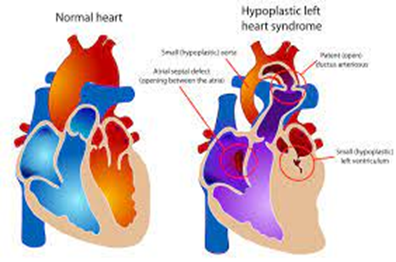Nick was diagnosed with Hypoplastic Left Heart Syndrome. Which of the following responses should the nurse educate his parents regarding the treatment of this disease?
Surgery is a palliative measure. The patient will require a heart transplant
The surgeon will create an opening between the atria and ventricles to allow oxygenated blood flow to the body. He should be cured with this simple surgery
This problem is caused by the displacement of the pulmonary artery and aortic artery. Surgery will be performed to put these arteries back in place.
His condition will improve greatly after we give him prostaglandin.
The Correct Answer is A
Hypoplastic Left Heart Syndrome is a complex congenital heart defect in which the left side of the heart (left ventricle and aorta) is underdeveloped, making it unable to pump oxygenated blood effectively to the body. The treatment of HLHS typically involves a series of surgical interventions because it cannot be cured with a single surgery. The ultimate goal of treatment is to provide palliative care, which means managing the condition to improve the child's quality of life while waiting for a heart transplant. The surgical procedures are typically performed in stages, with the first surgery usually performed shortly after birth, followed by additional surgeries as the child grows.
Option B is not accurate because HLHS cannot be cured with a single surgery, and creating an opening between the atria and ventricles (e.g., the Norwood procedure) is one step in the staged surgical treatment, but it doesn't completely "cure" the condition.
Option C is not accurate because HLHS is primarily characterized by an underdeveloped left ventricle and aorta, not the displacement of the pulmonary and aortic arteries.
Option D refers to the use of prostaglandin to maintain a patent ductus arteriosus (PDA) and improve blood flow to the lungs, which can be part of the initial management of HLHS but is not a definitive treatment. Prostaglandin is used to stabilize the infant before surgical interventions are performed.

Nursing Test Bank
Naxlex Comprehensive Predictor Exams
Related Questions
Correct Answer is ["B","D","F"]
Explanation
When developing a teaching plan to prevent urinary tract infections (UTIs), the following recommendations should be included:
B. Emptying bladder with urination: It's important to encourage regular and complete emptying of the bladder to help flush out bacteria and prevent their buildup.
D. Avoiding bubble baths and tight clothing: Bubble baths and tight clothing can irritate the genital area and increase the risk of UTIs, especially in children. Recommending gentle hygiene practices and loose-fitting clothing can help reduce this risk.
F. Maintaining adequate fluid intake: Staying well-hydrated can help dilute urine and flush out bacteria from the urinary tract, reducing the risk of infection.
The following recommendations are not appropriate or effective for preventing UTIs:
A. Keeping urine alkaline by avoiding acidic beverages: While it's true that some individuals believe that altering urine pH can prevent UTIs, this is not a reliable or evidence-based approach. It's not recommended to manipulate urine pH in an attempt to prevent UTIs.
C. Wearing underwear made of synthetic material such as nylon: The choice of underwear material is not a primary factor in preventing UTIs. However, it's generally recommended to wear breathable cotton underwear as it can help maintain a dry environment in the genital area.
E. Avoiding urination before and after intercourse: On the contrary, urinating before and after sexual intercourse is a recommended practice to help flush out any bacteria that may have entered the urethra during sexual activity.
In summary, teaching about proper bladder emptying, avoiding irritants like bubble baths and tight clothing, and maintaining adequate hydration are key components of preventing UTIs.
Correct Answer is B
Explanation
Decreased cardiac output is a common consequence of various cardiac conditions in children. In this scenario, the child's cool extremities and thready pulses indicate poor peripheral perfusion, which can occur when the heart is not effectively pumping blood to meet the body's demands. Decreased urinary output is another sign of poor cardiac output, as reduced blood flow to the kidneys can result in decreased urine production.
The other options may contribute to decreased cardiac output, but they are not the primary factors indicated by the clinical findings:
A. Increased afterload: Increased afterload can make it more difficult for the heart to pump blood effectively, but it is not the primary cause of the symptoms described.
C. Decreased contractility: Decreased contractility can reduce the heart's ability to pump blood, contributing to decreased cardiac output, but it is not the primary factor indicated by the clinical findings.
D. Increased stroke volume: An increase in stroke volume typically results in improved cardiac output, not diminished cardiac output as seen in this scenario.
Whether you are a student looking to ace your exams or a practicing nurse seeking to enhance your expertise , our nursing education contents will empower you with the confidence and competence to make a difference in the lives of patients and become a respected leader in the healthcare field.
Visit Naxlex, invest in your future and unlock endless possibilities with our unparalleled nursing education contents today
Report Wrong Answer on the Current Question
Do you disagree with the answer? If yes, what is your expected answer? Explain.
Kindly be descriptive with the issue you are facing.
